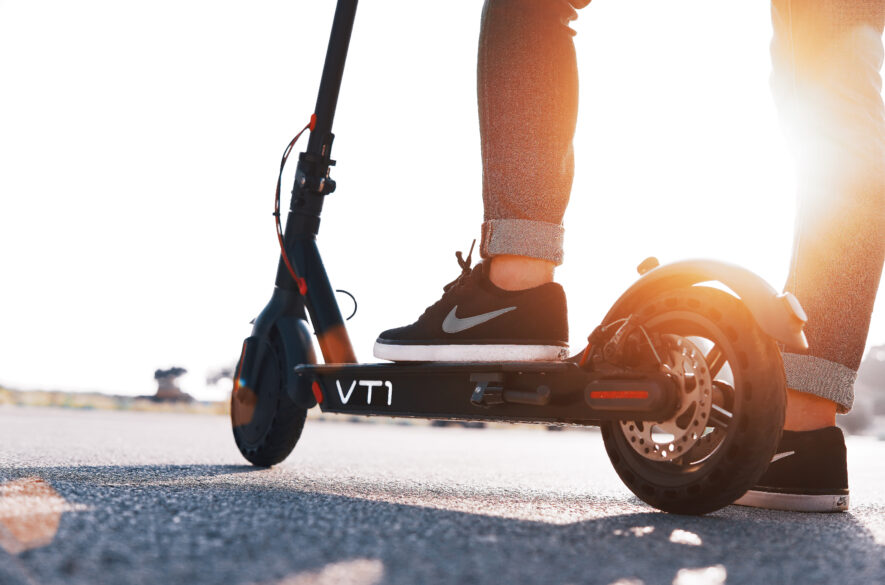The term “e-moped” is derived from the Swedish phrase “trampcykel med motor och pedaler,” which translates to “pedal cycle with motor and pedals.” However, the contemporary interpretation of a moped typically refers to a motorized two-wheeled vehicle without pedals. The specific definition can vary depending on local regulations, so it’s advisable to consult your local DMV/RMV for clarification. In essence, an e-moped, or electric moped, utilizes batteries for power instead of gasoline.
Most e-mopeds can attain speeds of up to 30 mph and have motor outputs ranging from 1 to 3 horsepower. In the realm of electric micro-mobility vehicles, e-mopeds fall on the larger side, resembling motorcycles but offering the convenience of electric scooters. They are well-suited for stylish daily commuting, quick grocery store runs, and efficient maneuvering through traffic. Moreover, e-mopeds are cost-effective and environmentally friendly as they operate solely on battery power.
E-mopeds have distinctive design features that differentiate them from other electric micro-mobility vehicles. They feature a step-through frame, allowing riders to sit on a lower seat, place their feet forward on a floorboard, and reach slightly higher for the handlebars. This design enhances comfort and adaptability, particularly for beginners.
E-mopeds serve as ideal vehicles for urban residents seeking to commute within city limits (typically 10-15 miles) on local roads or as secondary vehicles for shorter trips to places like the grocery store, gym, or social events.
Considerations Before Purchasing an E-Moped:
When contemplating the purchase of an e-moped, several factors warrant consideration:
Commute Distance: E-mopeds are well-suited for medium-range commutes (10-20 miles), providing greater speed than electric scooters or bikes and enhanced efficiency compared to driving through congested traffic. For shorter or longer commutes, alternative electric micro-mobility vehicles might be more suitable.
Safety Gear: Given that e-mopeds are used outdoors and can reach higher speeds, it’s essential to wear appropriate safety gear, including a US DOT standard helmet. Gloves and closed-toed shoes are also recommended.
Maintenance and Equipment: Like any vehicle, e-mopeds require routine maintenance and may need parts replacement. The battery is a crucial component, and it should be replaced periodically. Some offer battery leasing programs, simplifying maintenance and replacement.
Storage and Security: Adequate storage space is essential to keep your e-moped secure when not in use. It’s advisable to invest in security measures such as brake disc locks, grip locks, or chain locks to deter theft. Additionally, a waterproof cover can protect your vehicle from weather damage, particularly if it’s stored outdoors.
Pros and Cons of Owning an E-Moped:
Owning an electric moped offers several advantages:
Efficient Commuting: E-mopeds are nimble and can navigate through traffic easily, making city commuting enjoyable and traffic-free. Some states even allow e-mopeds to pass cars and use bicycle lanes, providing front-of-the-line privileges at traffic lights.
Cargo Space: Most e-mopeds feature storage compartments, which are invaluable for running errands, carrying groceries, or transporting goods.
Cost-Effective: E-mopeds are more economical to operate than cars or non-electric vehicles, as charging them is relatively inexpensive.
Reduced Noise Pollution: E-mopeds are silent due to their electric motors, enhancing the riding experience and situational awareness while reducing noise pollution.
Sustainability: E-mopeds contribute to a cleaner environment by eliminating the use of fossil fuels.
However, there are certain considerations when choosing an e-moped:
Restricted Access: E-mopeds are typically limited to non-recreational bike lanes and streets, excluding sidewalks and highways.
Minimal Physical Exercise: Unlike some other electric micro-mobility options, e-mopeds do not require physical exertion for travel.
Weight: E-mopeds are heavier than electric scooters and bikes, which can make carrying them upstairs for charging challenging. Some solutions, such as swappable batteries, may be necessary.
Difference Between Gas Mopeds and E-Mopeds:
In the realm of mopeds, there are two primary types: gas-powered and electric (e-mopeds). Gas mopeds are commonly associated with European culture and are featured in media as vehicles for navigating city streets and scenic landscapes. However, gas mopeds operate on gasoline engines and share more similarities with motorcycles than electric scooters.
On the other hand, e-mopeds rely on batteries and electric motors for propulsion. They gained prominence in China and have since become popular in Europe and North America as a more environmentally friendly option. Notably, e-mopeds produce no emissions, contrasting with gas mopeds, which emit pollution and are costlier to fuel.
Differences Between Electric Mopeds, Electric Scooters, and Electric Bikes:
As electric micro-mobility vehicles gain popularity, distinguishing between electric mopeds, electric scooters, and electric bikes can be confusing. These three vehicle types share the traits of being battery-powered, two-wheeled, and offering eco-friendly transportation options. However, they differ in terms of speed, design, lifestyle benefits, and legal requirements.
They are often mistaken for e-mopeds but are considerably slower, requiring riders to stand, and accommodating a single rider at a time. E-scooters have fewer restrictions and typically do not demand a license.
Electric bikes (e-bikes) are categorized as bicycles, exempting them from licensing and registration requirements. E-bikes combine human pedaling with electric assistance, with speed typically limited to 20-25 mph. They retain pedals, promoting exercise while commuting, and are generally allowed on bike paths, sidewalks, and off-road terrains.
In summary, e-mopeds offer an eco-friendly and efficient mode of transportation, but their suitability depends on factors like commute distance and individual preferences. Understanding the distinctions between electric mopeds, scooters, bikes, and gas mopeds, as well as the relevant licensing and registration requirements, can help individuals make informed choices when considering these electric micro-mobility options.









